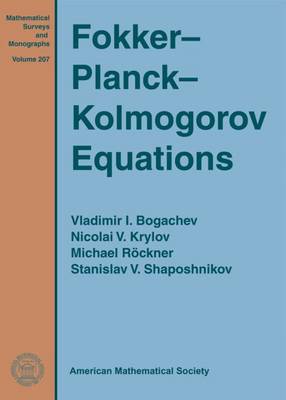Mathematical Surveys and Monographs
3 total works
This book gives a systematic exposition of the modern theory of Gaussian measures. It presents with complete and detailed proofs fundamental facts about finite and infinite dimensional Gaussian distributions. Covered topics include linear properties, convexity, linear and nonlinear transformations, and applications to Gaussian and diffusion processes. Suitable for use as a graduate text and/or a reference work, this volume contains many examples, exercises, and an extensive bibliography. It brings together many results that have not appeared previously in book form.
Fokker-Planck-Kolmogorov Equations
by Vladimir I. Bogachev, Nicolai V. Krylov, Michael Rockner, and Stanislav V. Shaposhnikov
Published 1 October 2015
This book gives an exposition of the principal concepts and results related to second order elliptic and parabolic equations for measures, the main examples of which are Fokker-Planck-Kolmogorov equations for stationary and transition probabilities of diffusion processes. Existence and uniqueness of solutions are studied along with existence and Sobolev regularity of their densities and upper and lower bounds for the latter. The target readership includes mathematicians and physicists whose research is related to diffusion processes as well as elliptic and parabolic equations.
This book provides a thorough exposition of the main concepts and results related to various types of convergence of measures arising in measure theory, probability theory, functional analysis, partial differential equations, mathematical physics, and other theoretical and applied fields. Particular attention is given to weak convergence of measures. The principal material is oriented toward a broad circle of readers dealing with convergence in distribution of random variables and weak convergence of measures.
The book contains the necessary background from measure theory and functional analysis. Large complementary sections aimed at researchers present the most important recent achievements. More than 100 exercises (ranging from easy introductory exercises to rather difficult problems for experienced readers) are given with hints, solutions, or references. Historic and bibliographic comments are included.
The target readership includes mathematicians and physicists whose research is related to probability theory, mathematical statistics, functional analysis, and mathematical physics.
The book contains the necessary background from measure theory and functional analysis. Large complementary sections aimed at researchers present the most important recent achievements. More than 100 exercises (ranging from easy introductory exercises to rather difficult problems for experienced readers) are given with hints, solutions, or references. Historic and bibliographic comments are included.
The target readership includes mathematicians and physicists whose research is related to probability theory, mathematical statistics, functional analysis, and mathematical physics.


